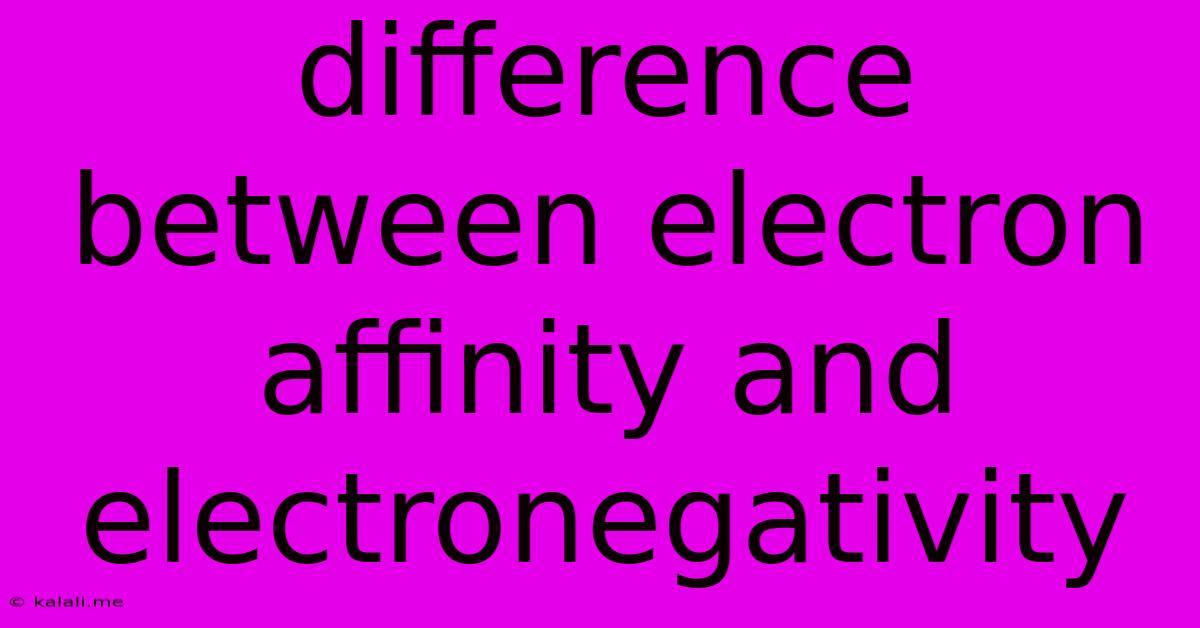Difference Between Electron Affinity And Electronegativity
Kalali
Jun 15, 2025 · 3 min read

Table of Contents
Electron Affinity vs. Electronegativity: Understanding the Key Differences
Understanding the concepts of electron affinity and electronegativity is crucial for grasping the intricacies of chemical bonding and reactivity. While both properties relate to an atom's attraction for electrons, they represent distinct aspects of this attraction. This article will delve into the differences between electron affinity and electronegativity, clarifying their definitions, measurement, and applications. This will help you understand the nuances of atomic behavior and chemical interactions.
What is Electronegativity?
Electronegativity describes an atom's ability to attract electrons within a chemical bond. It's a relative measure, comparing the pull of one atom's nucleus on shared electrons compared to another atom in a molecule. The higher the electronegativity value, the stronger an atom attracts electrons in a bond. Electronegativity isn't a directly measurable quantity like electron affinity; instead, it's calculated based on various atomic properties. The Pauling scale is the most commonly used electronegativity scale.
What is Electron Affinity?
Electron affinity, on the other hand, measures the energy change when a neutral atom gains an electron in the gaseous phase. It represents the atom's tendency to accept an electron. A high electron affinity indicates a strong attraction for the added electron, resulting in a release of energy (exothermic process). A low or even negative electron affinity suggests the atom is less likely to accept an electron, and may even require energy input (endothermic process). This is a directly measurable quantity, usually expressed in kJ/mol.
Key Differences Summarized:
| Feature | Electronegativity | Electron Affinity |
|---|---|---|
| Definition | Atom's ability to attract electrons in a bond | Energy change upon gaining an electron (gaseous phase) |
| Measurement | Calculated (e.g., Pauling scale) | Directly measured (kJ/mol) |
| Context | Within a chemical bond | Isolated atom gaining an electron |
| Scale | Relative scale (higher value = stronger attraction) | Absolute scale (positive/negative values) |
| Application | Predicting bond polarity, molecule shape | Understanding reduction potentials, chemical reactivity |
Understanding the Nuances:
While seemingly similar, the differences are crucial. Electronegativity focuses on the competition for electrons between atoms already bonded, while electron affinity deals with the intrinsic ability of an isolated atom to accept an electron. Electronegativity helps predict the nature of chemical bonds (ionic, covalent, polar covalent), while electron affinity provides insight into an atom's overall tendency to form anions.
Example:
Chlorine has a high electronegativity and a high (positive) electron affinity. This explains why chlorine readily forms covalent bonds with other atoms (due to high electronegativity) and readily accepts an electron to become a chloride ion (due to high electron affinity).
Conclusion:
In essence, electron affinity and electronegativity, while both related to an atom's attraction for electrons, provide different perspectives. Electronegativity reflects the competition for electrons within a bond, while electron affinity quantifies the energy change associated with an isolated atom gaining an electron. Understanding this distinction is essential for interpreting chemical behaviors and predicting molecular properties.
Latest Posts
Latest Posts
-
How Many Square Meters In A Mile
Jun 16, 2025
-
Which Of The Following Represents An Alpha Particle
Jun 16, 2025
-
The Planet With The Lowest Average Density Is
Jun 16, 2025
-
Number Of Valence Electrons In Cl Ion Are
Jun 16, 2025
-
Differentiate Between Leading Strand And Lagging Strand
Jun 16, 2025
Related Post
Thank you for visiting our website which covers about Difference Between Electron Affinity And Electronegativity . We hope the information provided has been useful to you. Feel free to contact us if you have any questions or need further assistance. See you next time and don't miss to bookmark.